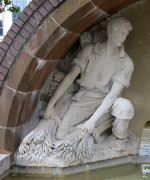
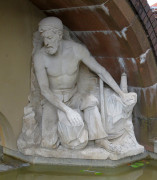
There are many good sculptural things in Bristol, but right in the commercial centre, a stroll along Broad Quay allows us to see several statues in close proximity.
We start at the southernmost end of the Quay by the water, strictly on St Augustineís parade, where there is a modern, low fountain and circular pool under a brick arch - the George V Memorial Fountain. On the one side is a cast lionís head, dating from 1983, but on the other are two stone figures of working men of an earlier period - see top of this page. The one, a slender young man kneeling in work trousers and wearing an open shirt with rolled up sleeves, is about to lift up two sheaves of corn; several more are benind him. The other, an older man with a beard, stripped to the waist, rests on a lump of rock; a pickaxe and a minerís lamp are beside him. Obviously these statues are older than the fountain, and their downward poised heads give the clue that these were originally positioned as part of a composition of architectural sculpture well above eye level: they come from the local headquarters building of the Co-operative Society, put up in 1908, and pulled down in the 1970s.
Dockside Shed E, and close up of spandrel girls.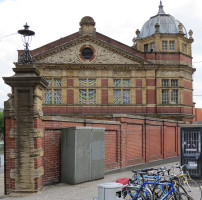
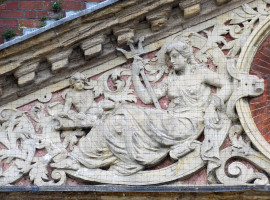
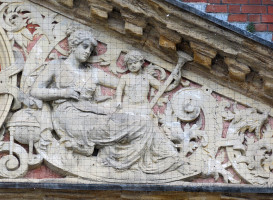
On the opposite side of the water is a Victorian building in stone and red brick with a dome and pediment, which was built as Dockside Shed E, by the locally prominent architect Edward Gabriel, the date being 1894. The dome has free-standing stone pots all the way round, effective for the skyline, and on the top an elegant weathervane with a ship, which apparently is modern (for more ship weathervanes, see bottom of this page. The pediment is interesting: to either side of a circular window or vent is a long spandrel containing a reclining girl in high relief, accompanied by a cherub, seated on a decorative scroll and with much background flourishes and smaller leaves and scrolls, making an ornamental covering to the available space. This style of decoration is often found on late Victorian and Edwardian buildings, for example on music halls, but is unusual for a dock shed. The girls are classically draped with Victorian faces, hairstyles and physiques. The one on the left holds a trident, and in the jolly rather than in any way serious composition, as well as the cherub, an owl sits among the scrolling (see this page if you like owl statues). On the other side, the girl has by her a globe on a stand, appropriate for a dock building, and the cherub holds a trumpet; one of the scrolls has a grotesque dragon head. Lots more spandrel girl sculpture on this page.
Proceeding northwards in the central pedestrian area of Broad Quay brings us immediately to the statue of Neptune, one of those rather grand lead statues from the 18th Century, set on a pedestal. He stands with his long trident in one hand, the other holding the tail of some great fish, a sturgeon I would think, which coils down and round to face forward, its toothy mouth gasping open. He wears a crown and a bit of strategically placed drapery, which is strapped to his body and also flies out behind and makes a loop over his back for compositional purposes to echo the curve of the fish below when the statue is seen in profile. His body is muscular, but not exaggeratedly so, and the soft metal and the age mean that the whole statue is somewhat smoothed, perhaps to the detriment of the face which wants more sternness and harshness than it presents today. A fine and well-posed statue and an asset to the city.
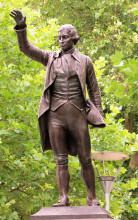 J. Havard Thomas's statue of Edmund Burke.
J. Havard Thomas's statue of Edmund Burke.
Next along up the Quay is a bronze statue of Edmund Burke, by the Bristol-born sculptor J. Havard Thomas. He is shown in oratory mode, one hand raised as he strides forward, the other holding a tricorn hat. He wears a buttoned waistcoat and tight breeches tucked into his tall boots, but these features are all softened and downplayed compared to his outer coat, which has some movement and appearance of drapery, and twisting folds on the sleeves. The piece was gifted by W. H. Wills, the tobacco industrialist whose contribution to the University includes the splendid Wills Tower.
A little further on the right, down a side alley we can see the beautiful 15th Century tower of St Stephen's Parish Church, highly visitable and with many monuments - see this page.
Edward Colston, by John Cassidy, and one of the fish or dolphins.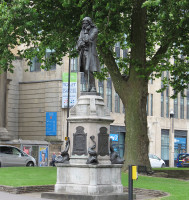
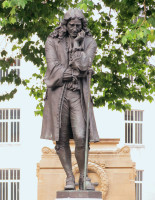
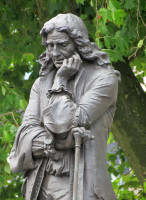
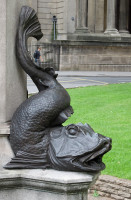
Next is the statue of Edward Colston, Bristol's great charitable benefactor, raised on a fairly high pedestal bearing bronze panels on each side and a writhing fish at each corner. It is tempting to put these down as dolphins, Colston's emblem, but it is hard to find anything dolphinlike about these creatures, with their ostentatiously bony heads, broadly ribbed fins, and ribbed tails. Fish is what they are. Anyway, the statue of Colston itself has him standing contemplatively, one hand resting on his long cane, his other elbow resting on that and supporting his chin. His clothes are of his time, - he died in 1721 - and the sculptor puts much detail to the fabric, to give a variety of small creases and folds without any grand Classical sweep. It is only from the side that we notice the rather high heels to his boots.
Colston memorial: the four panels round the base, also by John Cassidy.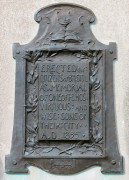
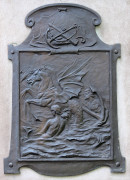
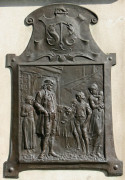
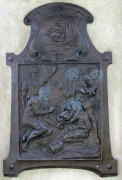
The panels around the base include an inscription in front, with a nice leafy border and above, a book, quill pen and lamp, and three low relief scenes around sides and back. THe best of these is on the right as we look at the statue - it shows a magnificent winged hippogryff rising from the water, webbed feet reared up; a second one is lightly sketched behind, and they hold together a large anchor, also supported by a merman. In the foreground, a mermaid faces away from us.
A second panel shows Colston in a charitable setting; a threadbare woman clasps a baby, a bedraggled youth stretches out a hand, a small girl has her head patted by Colston himself, who with his other hand reaches into his pocket. Behind, another woman and a girl; all bar Colston are barefoot on the cobbles. The background shows some fine doorway and the sails and masts of a ship, for Colston was a member of Bristol's Society of Merchant Venturers.
The third panel, with a group of four figures and a fifth and sixth whose heads are seen in the rear, is apparently a a legendary incident when a leak in one of Colston's vessels was plugged by a dolphin; the head of the beast can be seen, looking very fishlike again. The sculptor of the whole ensemble was John Cassidy, the founders, Coalbrookdale, and the date of the piece, 1895. For more on John Cassidy, see this page.
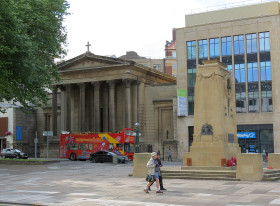 St Anne by the Quay, 1843, and Bristol Cenotaph.
St Anne by the Quay, 1843, and Bristol Cenotaph.
There follows the Cenotaph, an predominantly architectural rather than sculptural work, designed by Heathman and Blacker and dating from the early 1930s; the bronze coat of arms of the City is on the side, with little worn roundels of low relief flowers. We should also mention that on the left hand side of the road as we walk is the early Victorian Roman Catholic church of St Mary on the Quay, a basilica style church with six fluted Corinthian columns and a blank pediment. The church was completed in 1843, and the architect was Richard Shackleton Pope.
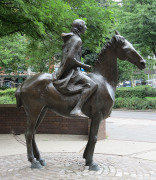 David Backhouse's Cloaked Horseman, 1980s.
David Backhouse's Cloaked Horseman, 1980s.
Broad Quay became Colston Avenue and then Lewins Mead, but we can continue a little further. On the left hand side of Colston Avenue we may note a modern piece as it is equestrian, called Cloaked Horseman by the sculptor David Backhouse, commissioned by Haslemere Estates and presented by them to the City in 1984. A rather simplified figure on a horse likewise stripped of most of the detail, excepting the mane, the emphasis being much on the flat surface planes, and the rather leaning pose of the animal. The sculptor's other work includes the comparable 'Animals in War' memorial in Park Lane, London.
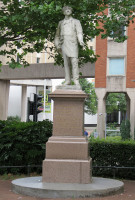
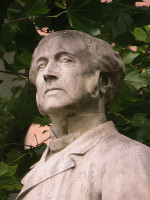 Samuel Morley statue by J. Havard Thomas.
Samuel Morley statue by J. Havard Thomas.
Our final statue, in the little grassy area on Lewins Mead, is that of the industrialist and local MP Samuel Morley. It is again by J. Havard Thomas, but in stone, and dates from 1887, thus a few years before the statue of Burke which is from 1894. Another oratorical pose, with the one hand held outwards with finger extended to illustrate some point, the other hand on his waist, the head uptilted and proud in expression. In contemporary dress with half-length coat and trousers, with no attempt to give a classical persona. Decent civic statuary Ė it is surprising that the city does not have much more of it.
Statues in Queen Square // Corn Street // A sculpturally decorated building in Corn Street // // Cabot Tower statue of Commerce // Decorated fountain by the Victoria Rooms
Christ Church with St Ewen, end of Corn Street // St Stephen's Church // Ruins of St Peter's Church, Castle Park // Ruins of Temple Church, off Victoria Street // Wesley Chapel sculpture // Bristol High Cross
Sculpture in England // Sculpture pages
Visits to this page from 13 Mar 2014: 3,961